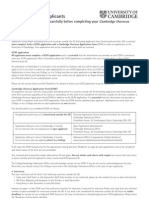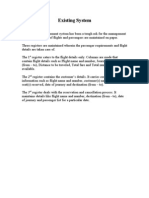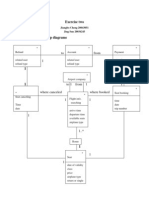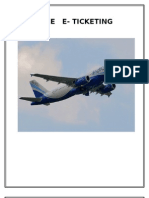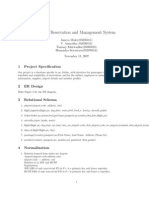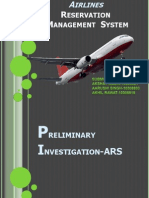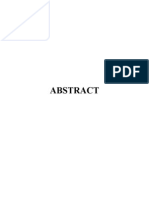Airline Reservation System
Airline Reservation System
Uploaded by
babuBGRCopyright:
Available Formats
Airline Reservation System
Airline Reservation System
Uploaded by
babuBGROriginal Description:
Copyright
Available Formats
Share this document
Did you find this document useful?
Is this content inappropriate?
Copyright:
Available Formats
Airline Reservation System
Airline Reservation System
Uploaded by
babuBGRCopyright:
Available Formats
1/ SCOPE Booking agents with varying levels of familiarity with computers will mostly use this system.
With this in mind, an important feature of this software is that it be relatively simple to use. The scope of this project encompasses: Flight_Information: The function allows the airline passenger to search for flights that are available between the two travel cities, namely the "Departure city" and "Arrival city". In the "Reservations" function, the system initially prompts the passenger for the two travel cities and displays a list of airline flights that are scheduled for these cities. ? When the passenger chooses for the information about the flight, flight details are shown as: Flight Number, Flight Fare and the total number of available seats in the flight. ? On Cancellation of a Ticket or Reservation, the total booked seats are decremented and are reflected in the flights details. After the system displays a list of available flights, the passenger is allowed to choose a particular flight and make reservations for that flight. Flight Status: When the passenger chooses a flight, he books the ticket to perform Flight Reservation. The details for the selected flight are queried from the ?flights? database. The flight details shown are: Flight number, Flight Fare, Departure City, Departure date (day of current month), Departure Time, Arrival City, Arrival date and Arrival time, number of seats available in a particular flight on a particular day. Passenger_Info: This module consists of the details of passenger?s booking for a flight. The personal details it consists are like Name, Age, Sex, Address, Email id and Contact Phone number. Booking/Reservation: This module consists of the entries made at the reception by the operator for the advanced ticket booking of a passenger. It contains Passenger No., Class, Fare, Ticket, Date of Journey, Date of Booking, Discount, and Total Fare. Cancellation of existing Flight Reservation : The system also allows the passenger to cancel an existing reservation. This function registers the information regarding a passenger who has requested for a cancellation of his/her ticket. It includes entries pertaining to the Flight No., Ticket No, Name, Source, Destination, Date of Journey, Fare deducted.
2/ DEFINITIONS, ABBREVIATIONS AND ACRONYMNS 1. Flight_No: The flight number is the defining key when it comes to the flight field. This key will be used when searching for a specific flight. Also the flight number must not be one that is already in use.
In other words it must be unique for the flight schedule. Examples of correct flight numbers are "ff001" and "ff324". 2. Airport_Name The airport attribute will consist of a character string having a maximum length of twenty-five. This character string will be the airport's name and will incorporate any combination of characters. An example of a valid entry will be "Kennedy Airport". 3. Departure Time: This attribute states about the departure of the flight and will consist of four positive digits that coincide with the twenty-four hour clock. It will be local time and must start with leading zeros if the hour time is not two digits. The first two digits will range from "00" to "23" and the last two digits will range from "00" to "59". An invalid entry will consist of negative digits, digits that are not of length four, and digits that do not fall into the range above. An example of a valid entry is "0130". 4. Arrival Time: The arrival time of a flight will consist of four positive digits that are in twenty-four hour clock mode. It will be local time and must start with leading zeros if the hour time is not two digits. The range of the first two digits are "00" to "23" and the range of the last two digits are "00" to "59". An invalid entry is one that will not fall into the above range, an entry that is negative, and digits that are not of length four. An example of a valid entry is "1234". 5. Destination: The destination place define the place where the land of the plane will take place and will be a city name. The field will be at most twenty characters long. An invalid entry will be a city name that is non-existent in the City database The computer prompts the user for a decision of either of the above options. An example of a valid entry is "Lethbridge".
6. Source: The arrival point will be a city name and it defines the location from where the flight will take off. The field consists of twenty characters and must be a valid city name. An invalid entry will be a city that is not on the flight list or a no occurrence of a city name in the City entity database. An example of an invalid entry is having an arrival point that is the same as the departure point. An example of a valid entry is "Calgary". 7. First Name: This is the passenger?s first name and this will also be a string of twenty characters containing only alphabetic characters and punctuation. Any string containing digits is invalid. Example: "John". 8. Address: This specifies the address of the passenger and this will be a string of fifty characters. This field is expected to include: building number, street, city, province, and postal code, in a form suitable for a mailing label. Example: "2500 University Dr. Calgary, AB T2L 0A0". 9. Phone number: This is the passenger?s phone number. It will consist of a three digit area code enclosed in parentheses plus a seven digit local number. The area code may not be omitted, but the
local code will be provided as a default. Example: "(403)2831752". 10. Login id: This is the login identification of the user in order to log into the reservation system. It consists of a string of ten characters. Letters of either uppercase or lowercase may be used, but the name must be a single word (ie no spaces). Example: "davidt". 11. Password: This is the security password that must be entered in order to enter in the appropriate login name to gain access to the reservation system. It will be stored in an encrypted format for security. It consists of a string of ten characters. Letters of either uppercase or lowercase may be used, but the name must be a single word (ie no spaces). Note that when this is entered or changed, the characters will not be displayed on the screen. 3/ REFERENCES MICROSOFT ACCESS AND VISUAL BASIC 2006 4/ OVERVIEW Airlines reservation basically includes issuing tickets to passengers who want to fly to a particular destination a particular day and time. Thus, the various activities that the airlines reservation encounter are checking the plane that flies to a particular from a starting point, checking the availability of seats in that particular flight and to issue the tickets if the seat is available. Then there is problem of cancellation. If a passenger for some reason wants to cancel a confirmed ticket, then the penalty is calculated based on the time the cancellation is made and the balance amount is refunded. The amount to be refunded is based upon the airlines? cancellation policy.
3.2 INPUT The system will require the various inputs under the following activities :? LOGIN FORM:? Username ? Password ? ? ? ? ? ? ? ? FLIGHT ENTRY FORM:Flight_no ( Flight number) Source Destination Days_ of_ op ( days of operation ) Departure_time Arrival_time No_of_seats ( number of seats )
? ? ? ? ?
FARE ENTRY FORM:Flight_no Class Ticket_type Fare_amount
? AGENT ENTRY FORM:? Agent_name ? Agent_cd ( agent code)
? ? ? ? ?
AIRPORT ENTRY FORM:Airport_code Airport_name City Country
? DISCOUNT ENTRY FORM:? Discount_code ? Dicount_percentage ? ? ? ? ? ? ? ? ? FLIGHT RESERVARTION FORM:Date_of_jour ( date of journey) Name Age Gender Address Phone Food E_mail
? FLIGHT STATUS FORM:? Flight_no ? Date_of_jour ? TICKET CANCELLATION FORM:? Pnr_no ( passenger number)
3.3 PROCESSING The system will generate the following under the given forms:? ? ? ? ? ? ? ? ? ? ? ? ? FLIGHT INFORMATION FORM:Source Destination Days_of_op Arrival_time Departure_time Fare_amt ( fare amount ) FLIGHT STATUS FORM:Source Destination Days_of_op Class Booked
? FLIGHT RESERVATION FORM:? Pnr_no ? ? ? ? TICKET CANCELLATION FORM Date_of_jour Name Age
? ? ? ? ? ? ? ? ? ?
Gender Address Phone Food E_mail Flight_no Ticket_type Class Disc_code ( discount code) Amount
3.4 OUTPUT The following will be produced as output:? Booked Ticket ? Cancelled Ticket and the balanced amount ? Query results( e.g. flight status)
4. EXTERNAL INTERFACE REQIREMENTS
4.1 USER INTERFACE
LOGIN SCREEN : The login screen, is the security window of the package. In this screen there are four items, the two text fields to enter the login name and also to enter the encrypted password. The ?cancel? button is to cancel the text that has been entered. If the password is entered correct, then only the package will be open.If a non-existent login name or incorrect password is entered, the user will not gain access to the system. The system will then re-initiate the login procedure at which point the user should ensure that the proper login name and password are being used. Validations: 1. Password should be in the encrypted form 2. Minimum length of password should be four characters.
MAIN SCREEN: This is the main screen of the package. It provides five options: -
1. ADMINISTRATION: It is for additional/ deletion of flights, change in the schedule, change in fare, change in discount etc. 2. FLIGHT: It is for obtaining information of a particular flight, its schedule, days of operation, fare for various classes etc 3. BOOKING/CANCELLATION: It is basically for the booking and cancellation of the seats for a particular flight. 4. REPORTS: It is for generating various kinds of reports. 5. Exit: This is present in order to exit from the system
ADMINISTRATION SCREEN: On clicking the administration option of main menu, a pull down menu is displayed. It has following five options. 1. FLIGHT MASTER: He is present for the addition /deletion or any change in the flight details. 2. AGENT MASTER He is present in order to keep track of how many agents are on the roll of company and what is their status i.e. working or nonworking. 3. FARE MASTER He is present for entering the fare for each flight as per type of ticket and class of interval 4. AIRPORT MASTER He is present to keep the record of airports present, connected by the airlines company, their locations and the city in which they are present. 5. DISCOUNT MASTER He is present to keep the record of types of discounts offered and its percentage on the fare amount.
FLIGHT SCREEN On clicking the flight option of main menu a pull down menu is displayed. It has two options 1. FLIGHT INFORMATION: It gives the details of the flight connecting two airports, its departure time, arrival time, flight number and days of operation. Further it provides information of the fare for the class opted. 2. FLIGHT STATUS: It gives the details of the seats available in a particular flight on a particular date.
BOOKING/CANCELLATION SCREEN On clicking the booking/cancellation of main menu a pull down is displayed. It has two options. 1. RESERVATION: It has further two sub options: a.) Reservation of a particular flight
b.) Issue of a boarding pass 2. CANCELLATION: Cancellation of the ticket for a particular flight is incorporated within this module.
REPORTS 1. PASSENGER LIST: This module basically helps in obtaining lists of passengers for a particular flight on a particular date. 2. BOOKING This module basically helps in obtaining lists of all the booked ticked for a particular flight on a particular date. 3. CANCELLATION: This module basically helps in obtaining lists of all the cancelled tickets for a particular flight on a particular date.
You might also like
- Airline Reservation System Project DocumentationDocument40 pagesAirline Reservation System Project DocumentationSahil Talwar77% (256)
- Airline ReservationDocument92 pagesAirline Reservationvrajesh_lucky50% (2)
- Warehouse Design For Airline ReservationDocument3 pagesWarehouse Design For Airline ReservationAvishek PramanickNo ratings yet
- Airline Management System - QuestionsDocument4 pagesAirline Management System - QuestionsAbanishAmp0% (2)
- Amadeus Textbook SpecimenDocument29 pagesAmadeus Textbook SpecimenPhanikumar MuralaNo ratings yet
- StretchersDocument8 pagesStretchersjjprietojNo ratings yet
- Cambridge Application FormDocument16 pagesCambridge Application FormNabiAliNo ratings yet
- Airline Reservation System ER AssignmentDocument6 pagesAirline Reservation System ER AssignmentAnupam UINo ratings yet
- ReportDocument11 pagesReportdNo ratings yet
- Airline Ticket Management System PROJECTDocument56 pagesAirline Ticket Management System PROJECTDiksha Prakash36% (11)
- 121910318041-SRS For Airport SimulationDocument5 pages121910318041-SRS For Airport SimulationPraveenNo ratings yet
- Travel Services Week2 Q3 1Document16 pagesTravel Services Week2 Q3 1Irish MacalalagNo ratings yet
- Test Project: It Software Solutions For BusinessDocument10 pagesTest Project: It Software Solutions For Businessศิลป์ ไชยวุฒิNo ratings yet
- Exercise TwoDocument4 pagesExercise TwoMuhammad FaaizNo ratings yet
- Requirements Analysis v1 - 0Document9 pagesRequirements Analysis v1 - 0Ishtiaq KhanNo ratings yet
- IPRG001 Assignment Part 1 - S3 2013Document3 pagesIPRG001 Assignment Part 1 - S3 2013Hùng Hùng Nguyễn NguyễnNo ratings yet
- Course-End Project: Air Cargo Analysis: Problem Statement ScenarioDocument10 pagesCourse-End Project: Air Cargo Analysis: Problem Statement ScenarioEduclent MegasoftelNo ratings yet
- 1A Student User GuideDocument215 pages1A Student User Guidemaymana moutieNo ratings yet
- Online E - Ticketing ReportDocument67 pagesOnline E - Ticketing ReportHallin ShanoNo ratings yet
- Smart 2 Carv 2 User GuideDocument55 pagesSmart 2 Carv 2 User GuideINSOFTDEVNo ratings yet
- Airline Reservation ReportDocument7 pagesAirline Reservation ReportS_D_MNo ratings yet
- Fallsem2023-24 Swe1004 Ela Vl2023240102719 Reference-MaterialDocument8 pagesFallsem2023-24 Swe1004 Ela Vl2023240102719 Reference-Materialdinesh kumar dkNo ratings yet
- Airline ReserevationDocument13 pagesAirline ReserevationdevenmakerNo ratings yet
- Akshay ArushiDocument20 pagesAkshay ArushiSwati MalikNo ratings yet
- Ars ProjectDocument24 pagesArs ProjectPappala ThanmaiNo ratings yet
- Abstract For Airline Reservation SystemDocument2 pagesAbstract For Airline Reservation SystemUniq ManjuNo ratings yet
- Hotel System SRSDocument9 pagesHotel System SRSmena7akimNo ratings yet
- Lab FATDocument21 pagesLab FATAkriti AgrawalNo ratings yet
- SRS Airline ReservationDocument7 pagesSRS Airline ReservationSuraj KumarNo ratings yet
- Assessment-1 Airline DatabaseDocument2 pagesAssessment-1 Airline DatabaseD. Ancy SharmilaNo ratings yet
- Airline DatabaseDocument2 pagesAirline DatabaseD. Ancy SharmilaNo ratings yet
- Group Wizard Web Light User Guide v1.1Document29 pagesGroup Wizard Web Light User Guide v1.1ilyabelkin7No ratings yet
- Flight Availability System: Name - Govind Masram Roll No. - M-10-31Document4 pagesFlight Availability System: Name - Govind Masram Roll No. - M-10-31Kamlesh SolankiNo ratings yet
- Assignment # 01: 'Aircrafts - CSV' 'R'Document5 pagesAssignment # 01: 'Aircrafts - CSV' 'R'Dhikri AlmuzahirNo ratings yet
- TMSS 107 Unit 3Document56 pagesTMSS 107 Unit 3Blezi Grace AquinoNo ratings yet
- SSD ExampleDocument6 pagesSSD ExampleShakil KhanNo ratings yet
- AirLine Reservation SystemDocument19 pagesAirLine Reservation SystemAmiralikhatriNo ratings yet
- Airline Reservation SystemDocument12 pagesAirline Reservation Systemmaqbool ahmedNo ratings yet
- Quick Guide Using IATA-SSIM FormatDocument12 pagesQuick Guide Using IATA-SSIM FormatKen Duc Cao100% (1)
- My ProjectDocument22 pagesMy Projectbarrylight2024No ratings yet
- Chapter 6 Air Travel and ToursDocument22 pagesChapter 6 Air Travel and Toursmonika ashokNo ratings yet
- AirlinesDocument49 pagesAirlinesRama Krishna Reddy50% (2)
- Air ReservationDocument3 pagesAir Reservationronak00789No ratings yet
- Airline Ticket Reservation System Documentation-Manasa IyerDocument14 pagesAirline Ticket Reservation System Documentation-Manasa IyerManasa MahadevanNo ratings yet
- of Airline Reservation System Project ReportDocument36 pagesof Airline Reservation System Project Reportpawan kumar64% (11)
- Airport Management System: Presentaion OnDocument12 pagesAirport Management System: Presentaion OnSuman LenkaNo ratings yet
- Lesson End ProjectDocument12 pagesLesson End ProjectRaviBishtNo ratings yet
- Airline Reservation SystemDocument1 pageAirline Reservation SystemAjay RavuriNo ratings yet
- Airline Reservation System: Project CS 441 Fall 2002Document12 pagesAirline Reservation System: Project CS 441 Fall 2002Saptak ChatterjeeNo ratings yet
- Project Report Airline Reservation SystemDocument23 pagesProject Report Airline Reservation SystemkratikapriyaNo ratings yet
- OpenFlights - Airport and Airline DataDocument4 pagesOpenFlights - Airport and Airline DataVishnu SatyaNo ratings yet
- Flight Reservation SystemDocument7 pagesFlight Reservation SystemAshutOsh SharMaNo ratings yet
- Airline ERDocument2 pagesAirline ERSahil Ahuja25% (4)
- Exchange Ticket MaskDocument187 pagesExchange Ticket MaskjjprietojNo ratings yet
- Terminolgy, Airline Code, StatusDocument18 pagesTerminolgy, Airline Code, Statustopperssc74No ratings yet
- OOP PROJECT REPORT - RashidDocument22 pagesOOP PROJECT REPORT - RashidFahad SiddiqNo ratings yet
- Merise Exercises EtudesDeCasDocument13 pagesMerise Exercises EtudesDeCas4gen_1100% (1)
- Airline Reservation System Using SDLCDocument3 pagesAirline Reservation System Using SDLCAl Muzammil MuhamadNo ratings yet
- CSCI3170 Introduction To Database Systems (2014 Spring) : Flight Booking SystemDocument10 pagesCSCI3170 Introduction To Database Systems (2014 Spring) : Flight Booking SystemGaryNo ratings yet
- Fill Rite Fuel MeterDocument12 pagesFill Rite Fuel MeterriobmNo ratings yet
- Geol 472 Subsurface Mapping: The Arrow Points atDocument8 pagesGeol 472 Subsurface Mapping: The Arrow Points atgadNo ratings yet
- O 1 03 01Document2 pagesO 1 03 01gplese0No ratings yet
- MSIDocument57 pagesMSINguyễn Anh VinhNo ratings yet
- Wires and CableDocument5 pagesWires and Cablewaz zuppNo ratings yet
- Solutionbank C1: Edexcel Modular Mathematics For AS and A-LevelDocument62 pagesSolutionbank C1: Edexcel Modular Mathematics For AS and A-LevelMomina ZidanNo ratings yet
- Do You Start A Research Paper With A QuestionDocument8 pagesDo You Start A Research Paper With A Questionfzqs7g1d100% (1)
- Front PageDocument3 pagesFront Pagekhushisharmambd56No ratings yet
- Learning From IncidentsDocument6 pagesLearning From IncidentsAndra SerbanNo ratings yet
- Houdini Foundations Gdc2018Document100 pagesHoudini Foundations Gdc2018WeiqingTeh100% (1)
- ENG101 Midterm Short Notes BY PIN2 and MUHAMMAD (MAS All Rounder)Document14 pagesENG101 Midterm Short Notes BY PIN2 and MUHAMMAD (MAS All Rounder)Sohaib NaeemNo ratings yet
- What Are Double-Byte, Single-Byte, and Multi-Byte Encodings?Document1 pageWhat Are Double-Byte, Single-Byte, and Multi-Byte Encodings?LionbridgeNo ratings yet
- Chemistry 122 Kinetics and Equilibrium Exam ReviewDocument12 pagesChemistry 122 Kinetics and Equilibrium Exam ReviewKyle GeryczNo ratings yet
- 11.microleakage in Restorative Dentistry / Orthodontic Courses by Indian Dental AcademyDocument8 pages11.microleakage in Restorative Dentistry / Orthodontic Courses by Indian Dental Academyindian dental academyNo ratings yet
- Computer-Aided Hazard Identification: Paul Chung (P.w.h.chung@lboro - Ac.uk) Department of Computer ScienceDocument38 pagesComputer-Aided Hazard Identification: Paul Chung (P.w.h.chung@lboro - Ac.uk) Department of Computer Scienceamit64007No ratings yet
- Module 2Document31 pagesModule 2ravi_nyseNo ratings yet
- TFN UstDocument81 pagesTFN UstTimi BCNo ratings yet
- Technical IndicatorsDocument2 pagesTechnical IndicatorsDebarshi MajumdarNo ratings yet
- Physics 71 LE2 ReviewerDocument14 pagesPhysics 71 LE2 ReviewerLoyd BascoNo ratings yet
- Touch Screen: A Report OnDocument27 pagesTouch Screen: A Report OnBHARATRKTNo ratings yet
- Https Raw - Githubusercontent.com Joelgrus Data-Science-From-Scratch Master Code Working With DataDocument7 pagesHttps Raw - Githubusercontent.com Joelgrus Data-Science-From-Scratch Master Code Working With DatagprasadatvuNo ratings yet
- METROLOGYDocument5 pagesMETROLOGYGangadhar TallaNo ratings yet
- Glass For Facade 2020Document53 pagesGlass For Facade 2020Rosa CandiaNo ratings yet
- Reservoir SurveillanceDocument28 pagesReservoir Surveillanceابوالحروف العربي ابوالحروفNo ratings yet
- Abcsplus MsdsDocument2 pagesAbcsplus MsdsCryotechDeicingNo ratings yet
- Questions For UXA InterviewDocument16 pagesQuestions For UXA InterviewPete SimonNo ratings yet
- Cross Cultural Issues & Challenges: WalmartDocument13 pagesCross Cultural Issues & Challenges: WalmartHARSHITA MATHURNo ratings yet
- Excel 2016 For Windows Keyboard ShortcutsDocument13 pagesExcel 2016 For Windows Keyboard Shortcutsmaoch 02No ratings yet
- DLL Week 4 MathDocument9 pagesDLL Week 4 MathGladish AnsubanNo ratings yet







